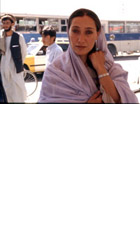
Return to Kandahar 2003
Distributed by Bullfrog Films, PO Box 149, Oley, PA 19547; 800-543-FROG (3764)
Produced by Icebreaker Films and J Films, Inc. in association with the Canadian Broadcast Corporation
Directed by Paul Jay and Nelofer Pazira
VHS, color, 65 min.
Sr. High - Adult
Anthropology, Canadian Studies, Ethics, History, International Studies, Military Studies, Political Science, Sociology Women's Studies
Date Entered: 04/07/2004
Reviewed by Linda Alkana, Department of History, California State University Long BeachSeven months after the fall of the Taliban, Nelofer Pazira, star of the movie Kandahar, returns to Afghanistan to search out her childhood friend Dyana. Pazira and her family had fled Russian-occupied Afghanistan thirteen years earlier. In the intervening years, the Russians left Afghanistan, the Taliban took over, Pazira moved to Canada, and then appeared in the award-winning Kandahar, a fictionalized account of the experiences of a friend she had left behind.
Now in her search for Dyana, Pazira travels from Kabul, to Kandahar and Masir-e-Sharif. She narrates her past and the history of the country as she journeys through the war-ravaged streets. War lords still command and women still cover themselves, not from Taliban law, but from fear. The directors of this remarkable film reveal far more than news coverage does about how the years of war and empty promises of peaceful reconstruction have wreaked a tragic toll on the people of Afghanistan. To these images of dusty, shell-marked streets and schools without books Pazira narrates her memories of earlier times. She also questions the people of Afghanistan about their lives, and argues with a near-mob of men who try to stop her from filming women. She interviews a man who removes landmines and asks that other countries stop sending mines. We need education, he says. She finds a refugee camp where her friend could be, and Pazira wonders if she could recognize her friend from the shoes, since the women at the camp were all wearing burquas. She negotiates with a war lord about information regarding her friend, and, when confronted with more demands from him, is unsure if the holdup is about money, or if it is dangerous. Throughout the film Pazira juxtaposes images of the streets and people of post-Taliban Afghanistan with her memories of the country where her physician father was jailed for his politics, and posters of Michael Jackson and Madonna adorned the city buildings. She asked her father if he believed things could have gotten worse. His surprise at how bad things became is reinforced by Pazira’s shock as she tours the country she left.
Return to Kandahar is bookended with textual information. The opening links this film with the earlier film, Kandahar. The film closes with the smiles of Afghan children and text that reveals that 75,000 armed men are still in service to the warlords, financed by drug and American money; an Afghan woman dies of pregnancy related causes every thirty minutes; one in four children will die before the age of five; and billions of dollars in promised aid have not arrived.
Awards
- Multiple International Awards including the 2003 Donald Brittain Award for Best Social Issue Documentary